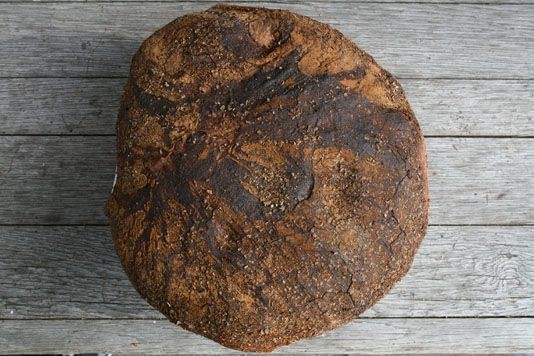Basic no-knead bread recipe

In November of 2006, Lahey's no-knead bread method drew the attention of "The Minimalist," culinary author Mark Bittman, resulting in a multitude of press coverage that sparked a worldwide home baking revolution.
Ingredients
- 3 cups Bread flour
- 1.33 cups Cool water
- 0.25 tsp Instant or other active dry yeast
- 8 g Salt
- 1 Sprinkling of flour, wheat bran, or cornmeal (for dusting)
Details
- Cuisine: American
- Recipe Type: Bread
- Difficulty: Easy
- Preparation Time: 30 mins
- Cooking Time: 60 mins
- Serves: 6
Step-by-step
- In a medium bowl, stir together the flour, salt, and yeast. Add the water and, using a wooden spoon or your hand, mix until you have a wet, sticky dough, about 30 seconds. Make sure it's really sticky to the touch; if it's not, mix in another tablespoon or two of water. Cover the bowl with a plate, tea towel, or plastic wrap and let sit at room temperature (approx. 18 - 21°C), out of direct sunlight, until the surface is dotted with bubbles and the dough is more than doubled in size. This will take a minimum of 12 hours and (my preference) up to 18 hours. This slow rise-fermentation-is the key to flavour.
- When the first fermentation is complete, generously dust a work surface (a wooden or plastic cutting board is fine) with flour. Use a bowl scraper or rubber spatula to scrape the dough onto the board in one piece. When you begin to pull the dough away from the bowl, it will cling in long, thin strands (this is the developed gluten), and it will be quite loose and sticky-do not add more flour. Use lightly floured hands or a bowl scraper or spatula to lift the edges of the dough in toward the centre. Nudge and tuck in the edges of the dough to make it round.
- Place a cotton or linen tea towel (not terry cloth, which tends to stick and may leave lint in the dough) or a large napkin on your work surface and generously dust the cloth with what bran, cornmeal, or flour. Use your hands or a bowl scraper or wooden spatula to gently lift the dough onto the towel, so it is seam side down. If the dough is tacky, dust the top lightly with wheat bran, cornmeal, or flour. Fold the ends of the towel loosely over the dough to cover it and place it in a warm, draft-free spot to rise for 1 to 2 hours. The dough is ready when it is almost doubled. If you gently poke it with your finger, making an indentation about ¼ inch deep, it should hold the impression. If it doesn't, let it rise for another 15 minutes.
- Half an hour before the end of the second rise, preheat the oven to 230-260°C, with a rack in the lower third position, and place a large covered heavy pot in the center of the rack.
- Using pot holders, carefully remove the preheated pot from the oven and uncover it. Unfold the tea towel, lightly dust the dough with flour or bran, lift up the dough, either on the towel or in your hand, and quickly but gently invert it into the pot, seam side up. (Use caution-the pot will be very hot.) Cover the pot and bake for 30 minutes.
- Remove the lid and continue baking until the bread is a deep chestnut colour but not burnt, 15 to 30 minutes more. Use a heatproof spatula or pot holders to carefully lift the bread out of the pot and place it on a rack to cool thoroughly. Don't slice or tear into it until it has cooled, which usually takes at least an hour.
Also worth your attention:
My Bread: The Revolutionary No-Work, No-Knead Method
Recipe: Phil Vickery's gluten free foccacia
The best breads to eat and bake